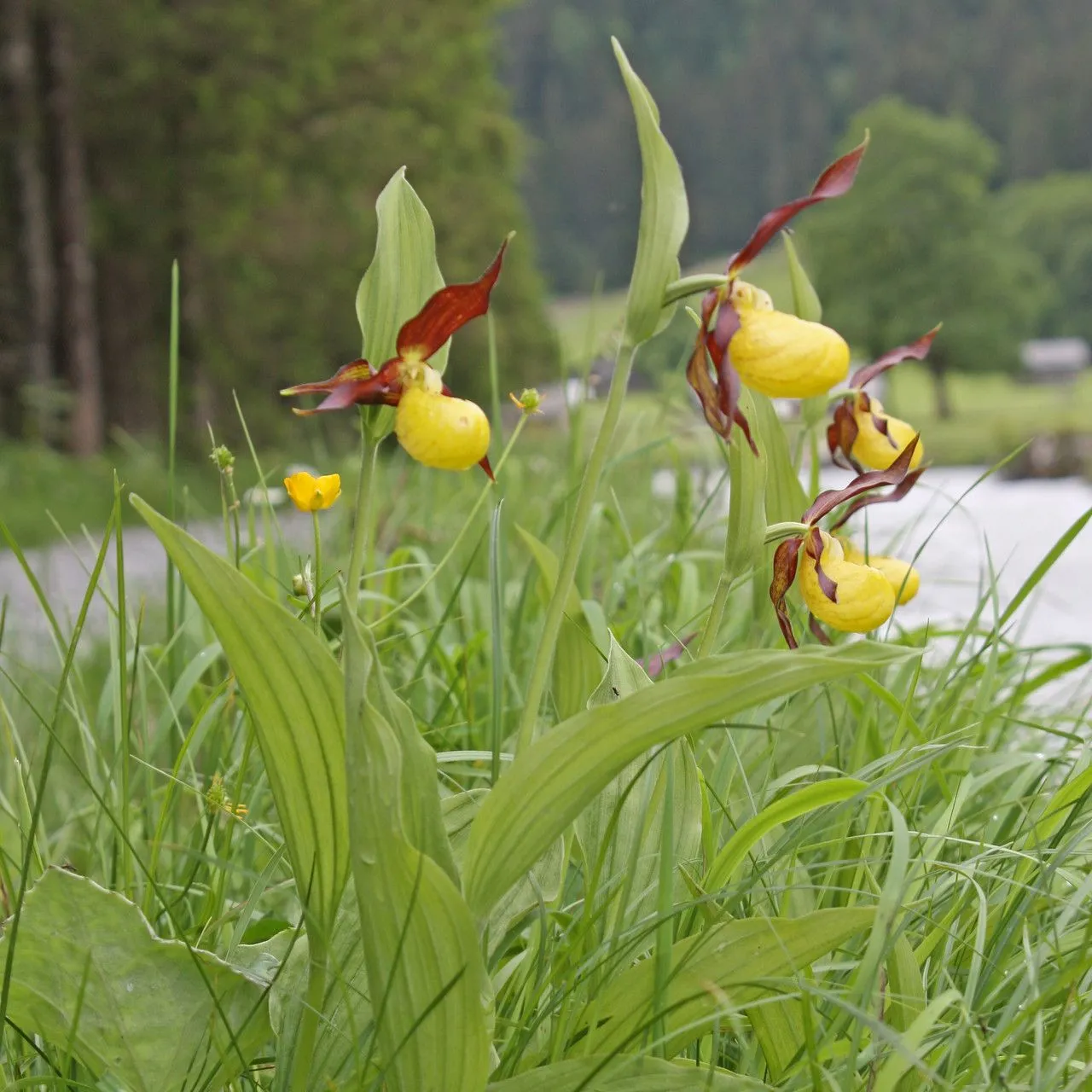
Author: L.
Bibliography: Sp. pl. 2:951. 1753
Year: 1753
Status: accepted
Rank: species
Genus: Cypripedium
Vegetable: False
Observations: Europe to N. Japan, Algeria (Djurdjura)
The Lady’s-slipper, scientifically known as Cypripedium calceolus, is a remarkable orchid species famed for its distinctive and beautiful flowers. This elegant plant belongs to the Orchidaceae family and has a fascinating history, first described in 1753.
The Lady’s-slipper is indigenous to a vast geographical range that spans across Europe to Northern Japan, including regions like Algeria’s Djurdjura mountains. This widespread occurrence hints at the species’ ability to adapt to various climates and environments, from the cooler woodlands of Europe to the diverse habitats found in Japan and Northern Africa.
Cypripedium calceolus is easily recognizable by its unique flower structure, which resembles a slipper, hence the common name. The plant’s vibrant yellow “slipper” is often complemented by burgundy or reddish-brown petals, making it a standout among flora. These stunning blooms are not just visually appealing but also play a crucial role in the plant’s reproduction, attracting pollinators with their striking appearance and subtle fragrance.
The Lady’s-slipper thrives in shaded, moisture-retentive soils, typically found in forested areas. This orchid prefers calcareous soils rich in humus and can often be located in deciduous or mixed forests where there is a lime-rich substrate. Its ecological preferences highlight the importance of habitat conservation, as the plant is sensitive to changes in its environment, particularly deforestation and land development.
Historically, Cypripedium calceolus has been admired not only for its beauty but also for its rarity. In many regions, it is considered a protected species due to habitat loss and over-collection. Conservation efforts are crucial for preserving this marvelous orchid, ensuring that future generations can continue to marvel at its beauty in its natural habitat.
Overall, the Lady’s-slipper is more than just a pretty flower; it is a symbol of botanical elegance and ecological significance. Its widespread distribution and unique appearance make it a fascinating subject for botanists and plant enthusiasts alike.
Deu: europäischer frauenschuh, frauenschuh, marien-frauenschuh, gelber frauenschuh
Dan: fruesko, stor fruesko
Eng: lady’s-slipper, lady’s-slipper orchid, lady’s slipper orchid
Nor: marisko
Lav: dzeltena dzeguzkurpite
Swe: guckusko, lehtotikankontti
Fin: lehtotikankontti
Nob: marisko
Nno: marisko
Fra: sabot de vénus
Nld: vrouwenschoentje
Sme: giegagáma, gáma, nieiddagáma
Cym: esgid fair
Zho: shao lan
Spa: zapatito de dama
En: Lady’s-slipper, Lady’s-slipper orchid, Yellow Lady’s Slipper, Lady’s slipper orchid, Gählè Frauèschuèh, Ladies Slipper Orchid, Yellow Ladies Slipper Orchid, Nerve Root
Ar: خف السيدة الأصفر
Az: Əsl zöhrəçiçəyi
Be: Венерын чаравічак сапраўдны
Bg: Венерина пантофка
Ca: Sabatetes de la Mare de Déu
Zh: 杓兰, Shao lan
Cv: Венера пушмакĕ
Hr: Gospina papučica
Cs: Střevičník pantoflíček, Střevíčník pantoflíček
Da: Fruesko, Stor Fruesko
Nl: Vrouwenschoentje
Et: Kaunis kuldking
Fi: Tikankontti, Lehtotikankontti
Fr: Sabot de Vénus, Sabot-de-Vénus, Sabot-de-Vénus d’Europe, Pantoufle de Notre-Dame, Soulier-de-la-Vierge, Pantoufle-de-Notre-Dame
De: Marien-Frauenschuh, Gelber Frauenschuh, Frauenschuh, Europäischer Frauenschuh
Hu: Boldogasszony papucsa
It: Pianelle della Madonna, Scarpetta di Venere, Pianella della madonna, Forfallone
Kk: Кәдімгі шолпанкебіс
Kv: Кöккоті, Кӧккоті
Lv: Dzeltenā dzegužkurpīte, Dzeltena dzeguzkurpite
Lt: Plačialapė klumpaitė, Placialape klumpaite
Se: Giegagáma, Gáma, Nieiddagáma
No: Fruesko, Marisko, Orkideen marisko
Nb: Marisko
Nn: Marisko
Fa: ارکیده دارزی
Pl: Obuwik pospolity
Ro: Papucul doamnei
Ru: Башмачок настоящий
Sr: Госпина папучица
Sk: Črievičník papučkový
Es: Zapato de Venus, Lepi čeveljc, Zueco de dama, Zapatito de Dama
Sv: Guckusko, Lehtotikankontti
Zh-tw: 杓蘭
Tt: Чын кәккүк читеге
Th: รองเท้านารีสีทอง
Uk: Зозулині черевички справжні
Cy: Esgid Fair
Taken Jul 9, 2005 by Andre Etienney (cc-by-sa)
Taken Sep 18, 2019 by Julia Ultsch (cc-by-sa)
Taken May 17, 2017 by martha (cc-by-sa)
Taken Jul 17, 2019 by Sperling Dominik (cc-by-sa)
Taken May 31, 2020 by Traktor_5000 (cc-by-sa)
Taken Jun 2, 2021 by Jacques Zuber (cc-by-sa)
Taken May 30, 2020 by beurny (cc-by-sa)
Taken Jun 14, 2020 by Michel Julien-Laferrière (cc-by-sa)
Taken Jun 20, 2009 by Wolfgang Mölders (cc-by-sa)
Taken May 26, 2022 by Jacques Zuber (cc-by-sa)
Taken Jun 19, 2014 by Tela Botanica − Combis Regis (cc-by-sa)
Taken Jan 1, 1970 by Photoflora – L’Abbé COSTE (©)
Taken May 27, 2022 by denise.lavorel (cc-by-sa)
Taken May 31, 2020 by Traktor_5000 (cc-by-sa)
Taken Jun 10, 2019 by youpichou (cc-by-sa)
Taken Jun 26, 2021 by Jean Ciroux (cc-by-sa)
Taken Jun 11, 2022 by Victoria eutopa (cc-by-sa)
Taken Jun 12, 2021 by Bernard Haute Savoie (cc-by-sa)
Taken May 26, 2022 by Jacques Zuber (cc-by-sa)
Taken Jun 8, 1997 by Tela Botanica − Liliane Roubaudi (cc-by-sa)
Taken Jun 4, 2019 by Tela Botanica − Marie Portas (cc-by-sa)
Taken Jun 6, 2008 by Tela Botanica − Liliane Roubaudi (cc-by-sa)
Taken Jul 2, 2021 by Daniel Barthelemy (cc-by-sa)
Taken Jun 1, 2001 by Tela Botanica − Liliane ROUBAUDI (cc-by-sa)
Taken Jun 4, 2019 by Tela Botanica − Marie Portas (cc-by-sa)
Taken Jun 17, 2022 by Roy Carstens (cc-by-sa)
© copyright of the Board of Trustees of the Royal Botanic Gardens, Kew.
© copyright of the Board of Trustees of the Royal Botanic Gardens, Kew.
© copyright of the Board of Trustees of the Royal Botanic Gardens, Kew.
Ph maximum: 8.0
Ph minimum: 7.5
Light: 5
Atmospheric humidity: 5
Bloom months: [‘may’, ‘jun’, ‘jul’]
Soil nutriments: 4
Family: Myrtaceae Author: (F.Muell.) K.D.Hill & L.A.S.Johnson Bibliography: Telopea 6: 402 (1995) Year: 1995 Status:…
Family: Rubiaceae Author: Pierre ex A.Froehner Bibliography: Notizbl. Bot. Gart. Berlin-Dahlem 1: 237 (1897) Year:…
Family: Sapindaceae Author: Koidz. Bibliography: J. Coll. Sci. Imp. Univ. Tokyo 32(1): 38 (1911) Year:…
Family: Asteraceae Author: A.Gray Bibliography: Pacif. Railr. Rep.: 107 (1857) Year: 1857 Status: accepted Rank:…
Family: Fabaceae Author: Medik. Bibliography: Vorles. Churpfälz. Phys.-Ökon. Ges. 2: 398 (1787) Year: 1787 Status:…
Family: Aspleniaceae Author: (Cav.) Alston Bibliography: Bull. Misc. Inform. Kew 1932: 309 (1932) Year: 1932…